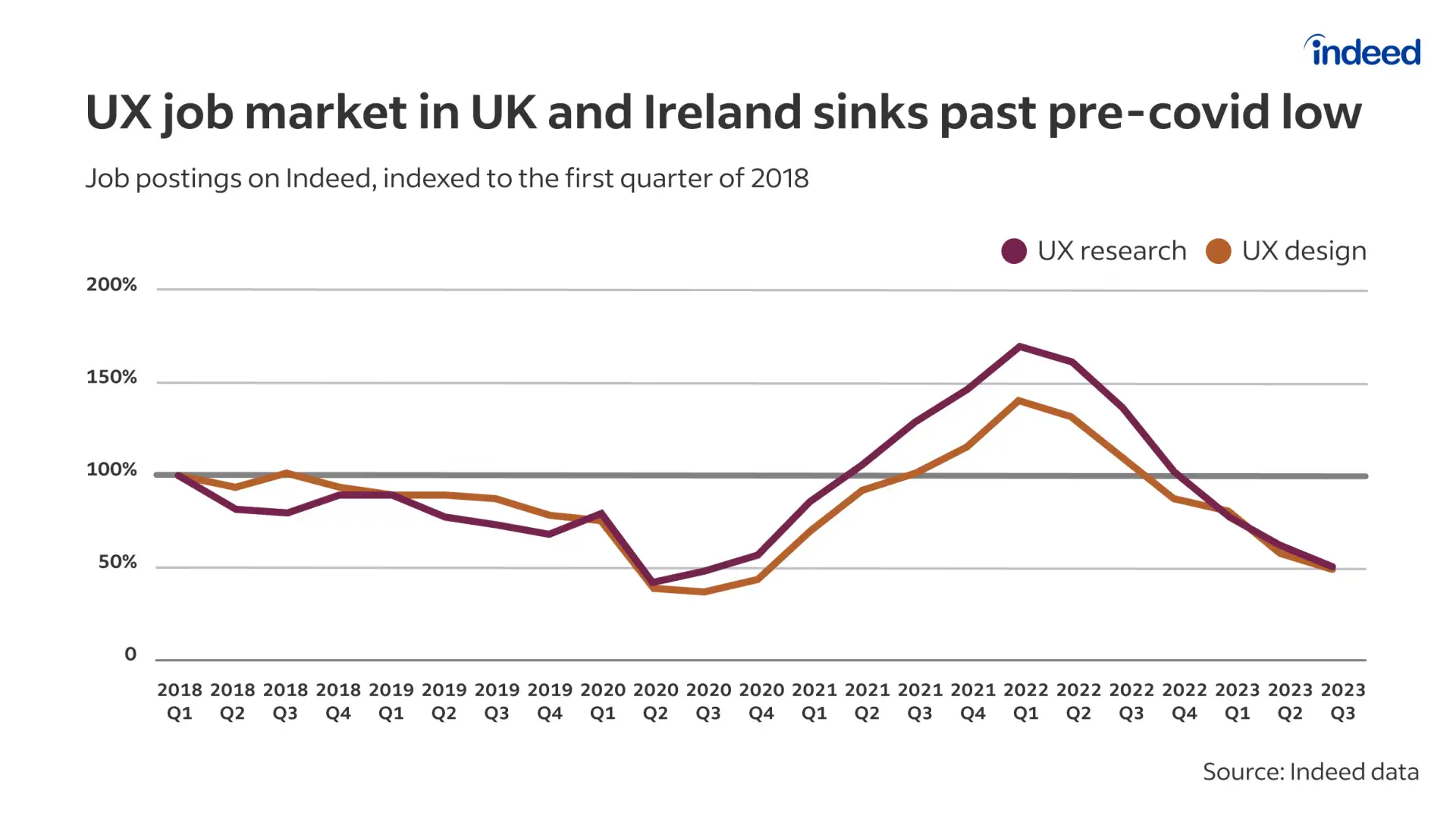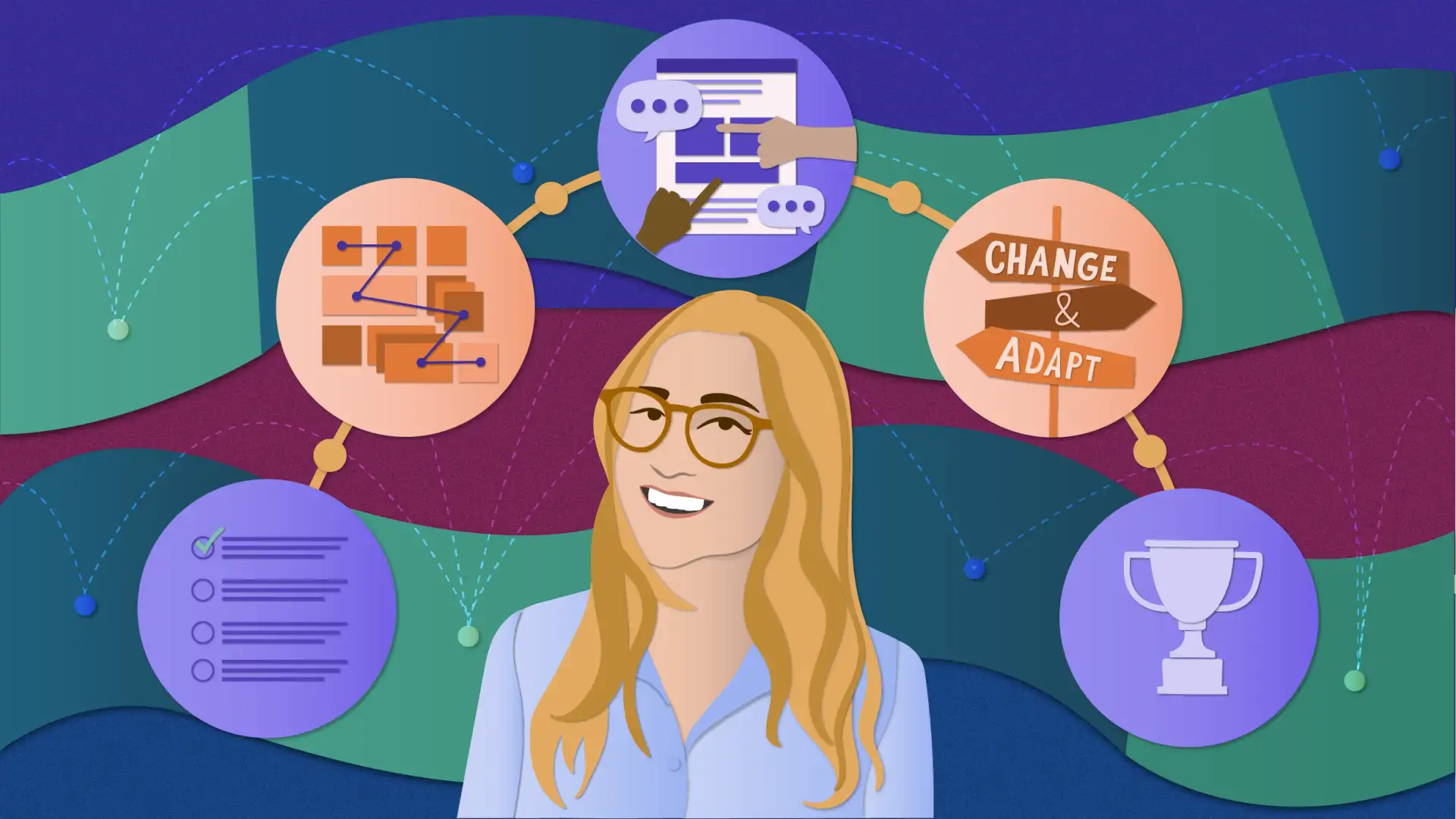When I graduated college, I saw my UX design degree as the ultimate 21st century treasure. The Skills and Tools section on my resume was lofty, and perhaps a bit elevated. I truly thought my portfolio was rock solid. And my overconfidence was through the roof.
Since my curriculum had incorporated human-computer interaction principles, user research, basic coding, and other relevant topics, I naively thought I’d be a UX rockstar right away. Instead, I swiftly found myself uncertain, confused, and back to square one after starting my first UX design role at Indeed in July 2022.
No matter how exhaustive and multifaceted a design curriculum is, some lessons are inevitably learned only from experience. For those in a UX design program or thinking of starting one, here are five things design school might not fully teach you. These are only my personal experiences. I hope some of it resonates with you and helps you prepare for your future design role!
1. Designs need to be measurable
Sorry, getting a good grade on a homework assignment doesn’t count as a real-world project success.
Throughout my first year in a UX role, my definitions of good and successful design have evolved beyond what looks nice and what the user says they like. Many programs drill design laws to teach what’s theoretically good and why it works based on the psychology behind it. Your design might be strong fundamentally, but its true success should be measured by how much it solves your user’s problem.
My first product design class concentrated on user needs and solving them with high-fidelity prototypes. In an academic setting, reviewers measured my solutions qualitatively with heuristic evaluations and user interviews. Professionally, using heuristics and interviews still apply, but validating a working product is more complex than evaluating an educational prototype.
At the end of the day, you’re working for a company with its own business objectives, and bottom-line decisions can be hard to recreate in the classroom. Your designs need to tackle product and user needs together. Most programs will teach this, but it can be hard to put into action. Rich, qualitative evidence is still important in sketching your success. But quantitative data shows the impact of your design and helps you see the full picture.
Now, let’s pause to clarify. Just because good design should align with clear measures and business goals doesn’t mean your team’s ultimate success is making money. Here’s what I’m trying to say: You might have an amazing design idea, but if you can’t link it to a measurable objective or make a strong business case, leadership might not want to develop it. To make your designs successful, stay true to the fundamentals you learned in school while measuring your designs in a concrete way.
2. Design and development take longer than you think
You can only cram so much into a semester, and professional UX design doesn’t always fit into a predictable process.
My design timelines used to depend on due dates set by college professors. I habitually worked on a project for a semester, submitted it, and then erased it from my mind. However, the reality is that UX work is long lasting, and good design takes time.
What once took a month to brainstorm, research, wireframe, and prototype now takes longer — sometimes even half a year. That’s because a real UX product lifecycle involves many stakeholders and limitations, and incorporating everyone’s expertise takes time. Just because I spent an afternoon prototyping an idea doesn’t mean an engineer will code it as quickly or a product manager will prioritize it right away. Be prepared that something you design might take longer to reach the finish line.
Another reason behind lengthier professional timelines is the inherent risk with design changes. Designing at larger companies means that your work serves millions of people. This immense scope requires even smaller changes to prove successful in testing before fully launching.
Google once A/B tested 41 shades of blue to determine which would increase revenue. In my UX classes, I’d pick a color in 30 seconds and never second-guess it or its effect on the user. Running tests with specific measures in mind is important for ensuring solutions are data-driven and successful, but they take time.
Given the stretched out process, be extra intentional with your designs and keep longevity in mind. Instead of asking what the impact will be tomorrow or next week, start asking what the next few months or years will look like with or without this design.
3. Cross collaboration looks different in practice than theory
Here’s a helpful hint about collaborating in the professional world: There’s not one right way to do it.
If you’ve taken a UX class, you’ve probably seen the venn diagram of business, technology, and design, with UX sitting neatly in the middle.
Educators emphasized what cross-functional collaboration might look like with ideas like aligning on business goals and checking for technical feasibility. But without practitioners from other disciplines, it was hard to practice true collaboration since my peers were fellow designers. School does a great job of teaching you about the other roles involved in the design process and why you collaborate, but experience teaches you when and how to do it.
I’ll admit, I was naive and thought cross-collaboration was a linear process. A designer designs something and then asks an engineer if they can build it — right? Not quite. I quickly learned that looping in stakeholders should be happening at beginning stages before Figma is even opened. Sparking the conversation with cross-functional partners helps make sure that success is defined, roles are identified, and there are no surprises later in the process.
—
Is this article helpful? Subscribe to get occasional emails with new stories like it.
—
Knowing when to collaborate is important; knowing how is even more critical. Collaboration involves communicating in different languages. How you talk to a product manager about your designs will (and should) be different from how you talk to an engineer.
For example, with a developer, you might describe the exact code components that you’re altering. With a product manager, you might talk about which business objectives you’re targeting. The ability to alter your communication depending on the recipient’s role and priorities will help you grow as a collaborator.
Realistically, having collaborative relationships is a two-way street. With time and practice, you and your partners will develop a practice together that works best for you.
4. Existing design systems change your workflow
Hug your design system team extra tight. They work hard to ensure you have the right guidelines for the job.
School teaches you a little bit of everything, especially when it comes to visual design and UI. A chunk of my curriculum covered designing end-to-end experiences and creating components from scratch (as unpolished as they were). I spent too much time tweaking the border radiuses on buttons, contemplating font types and sizes, and using squares to measure spacing. Knowing how to design from scratch has still been useful, but I’ve done it way less than I anticipated.
Luckily, companies like Indeed have dedicated design system teams to do a lot of the UI design work upfront. Having a system with clear standards and reusable components speeds up your design process so you spend less time creating elements like illustrations and more time making sure the overall experience is solid.
Design systems also change your workflow by influencing your ideas and solutions. Assets in a design system have been vetted; teams know that they’re accessible and usable. When possible, you can use existing components to piece together a solution which will save time and effort for designers and developers.
Bonus: If you don’t feel confident with Figma’s Auto Layout, please do yourself a favor and watch a Youtube video or two on it. Auto Layout combined with design system components has been a game changer. If I had a time machine and could tell my younger designer self anything, it would be this.
5. New design isn’t always the solution
It’s good for a designer to know the difference between asking what a team should build and whether they should build something in the first place.
Learning how to design digital experiences is one of the most important things you learn in design school. A lot of my homework assignments were about ideating new products we could create to solve problems. Yet we rarely talked about when to not design something.
As a designer who aims to have an informed UX perspective, it’s your job to evaluate a concept and suggest whether it should be built or not. You’re an advocate for the user’s needs and pain points. Sometimes advocating is pushing back on a design that might be harmful or not serve the user’s best interest.
I used to think designers should always think about how to redesign or add things. But knowing when to take a step back and identify what’s worth eliminating is an incredible skill to learn.
Take your new UX role one day at a time
If there’s one thing to take away, it’s this: You’ll keep learning more and more after your UX program. It just takes time. Learning never ends, and it’s impractical for one curriculum to include everything you’ll need.
If you’re eager to get started on building your professional experience, find chances to get involved in real projects. Pair up with some computer science students and make an app. Help a local business redesign their website. There are lots of opportunities outside of the classroom that can help you smooth the transition from school to work. It just requires some initiative.
Instead of worrying about the things you still have to learn, lean into it. Be a sponge, and get excited to absorb even more tools and techniques. Fall back on the processes and theories you’ve learned in school, and use that as a way to set yourself apart.
At the end of the day, we will never learn everything. And that’s OK.




